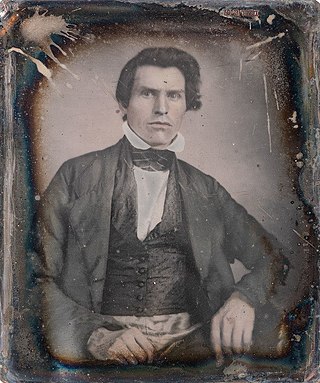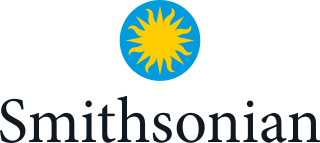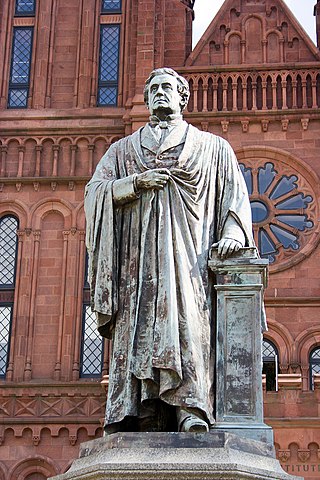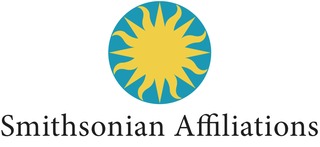
The Smithsonian Institution, or simply the Smithsonian, is a group of museums, education and research centers, the largest such complex in the world, created by the U.S. government "for the increase and diffusion of knowledge." Founded on August 10, 1846, it operates as a trust instrumentality and is not formally a part of any of the three branches of the federal government. The institution is named after its founding donor, British scientist James Smithson. It was originally organized as the United States National Museum, but that name ceased to exist administratively in 1967.

Joseph Henry was an American scientist who served as the first secretary of the Smithsonian Institution. He was the secretary for the National Institute for the Promotion of Science, a precursor of the Smithsonian Institution. He also served as president of the National Academy of Sciences from 1868 to 1878.

Charles Greeley Abbot was an American astrophysicist and the fifth secretary of the Smithsonian Institution, serving from 1928 until 1944. Abbot went from being director of the Smithsonian Astrophysical Observatory, to becoming Assistant Secretary, and then Secretary of the Smithsonian Institution over the course of his career. As an astrophysicist, he researched the solar constant, research that led him to invent the solar cooker, solar boiler, solar still, and other patented solar energy inventions.

Spencer Fullerton Baird was an American naturalist, ornithologist, ichthyologist, herpetologist, and museum curator. Baird was the first curator to be named at the Smithsonian Institution. He eventually served as assistant Secretary of the Smithsonian from 1850 to 1878, and as Secretary from 1878 until 1887. He was dedicated to expanding the natural history collections of the Smithsonian which he increased from 6,000 specimens in 1850 to over 2 million by the time of his death. He also served as the U.S. Commissioner of Fish and Fisheries from 1871 to 1887 and published over 1,000 works during his lifetime.

The National Museum of the American Indian is a museum in the United States devoted to the culture of the Indigenous peoples of the Americas. It is part of the Smithsonian Institution group of museums and research centers.

Cleveland Abbe was an American meteorologist and advocate of time zones.

The National Museum of Natural History (NMNH) is a natural history museum administered by the Smithsonian Institution, located on the National Mall in Washington, D.C., United States. It has free admission and is open 364 days a year. With 4.4 million visitors in 2023, it was the second most-visited museum in the United States.

A patent model was a handmade miniature model no larger than 12" by 12" by 12" that showed how an invention works. It was one of the most interesting early features of the United States patent system.

The Smithsonian American Art Museum is a museum in Washington, D.C., part of the Smithsonian Institution. Together with its branch museum, the Renwick Gallery, SAAM holds one of the world's largest and most inclusive collections of art, from the colonial period to the present, made in the United States. More than 7,000 artists are represented in the museum's collection. Most exhibitions are held in the museum's main building, the Old Patent Office Building, while craft-focused exhibitions are shown in the Renwick Gallery.

Robert McCormick Adams Jr. was an American anthropologist and secretary of the Smithsonian Institution (1984–94). He worked in both the Near East and Mesoamerica. A long time professor of the University of Chicago, he was best known for his research in Iraq.

The United States Exploring Expedition of 1838–1842 was an exploring and surveying expedition of the Pacific Ocean and surrounding lands conducted by the United States. The original appointed commanding officer was Commodore Thomas ap Catesby Jones. Funding for the original expedition was requested by President John Quincy Adams in 1828; however, Congress would not implement funding until eight years later. In May 1836, the oceanic exploration voyage was finally authorized by Congress and created by President Andrew Jackson.

Children's museums are institutions that provide exhibits and programs to stimulate informal learning experiences for children. In contrast with traditional museums that typically have a hands-off policy regarding exhibits, children's museums feature interactive exhibits that are designed to be manipulated by children. The theory behind such exhibits is that activity can be as educational as instruction, especially in early childhood. Most children's museums are nonprofit organizations, and many are run by volunteers or by very small professional staffs.

The Volta Laboratory and the Volta Bureau were created in Georgetown, Washington, D.C., by Alexander Graham Bell.

Henry Fitz Jr. was an American engineer, scientist, locksmith, optician, inventor and a pioneer of photography in the United States.

Smithsonian Libraries and Archives is an institutional archives and library system comprising 21 branch libraries serving the various Smithsonian Institution museums and research centers. The Libraries and Archives serve Smithsonian Institution staff as well as the scholarly community and general public with information and reference support. Its collections number nearly 3 million volumes including 50,000 rare books and manuscripts.

Professor Joseph Henry, also known as the Joseph Henry Memorial, is an outdoor bronze sculpture depicting scientist Joseph Henry, the first president of the Smithsonian Institution. The statue stands in front of the Smithsonian Institution Building in Washington, D.C., facing the National Mall. It was sculpted by artist William Wetmore Story, and dedicated in 1883, a few years after Henry's death. The bronze statue and granite base were unveiled in front of thousands of onlookers and invited guests. Speeches at the dedication included one from Chief Justice of the Supreme Court Morrison Waite, and the president of Yale College, Noah Porter.

The Department of Entomology is a research department and collection unit of the Smithsonian Institution's National Museum of Natural History (NMNH), located in Washington, D.C. The department houses the U.S. National Insect Collection, one of the largest entomological collections in the world, with over 35 million specimens housed in 132,354 drawers, 33,000 jars or vials, and 23,000 slides in more than 5,200 cabinets. The department also includes research scientists and technical staff from the Smithsonian Institution, the United States Department of Agriculture Systematic Entomology Lab (SEL) and United States Department of Defense Walter Reed Biosystematics Unit (WRBU).

Smithsonian Affiliations is a division of the Smithsonian Institution that establishes long-term partnerships with non-Smithsonian museums and educational and cultural organizations in order to share collections, exhibitions and educational strategies and conduct joint research. Partner organizations are known as "Smithsonian Affiliates".

Jefferson Pinder is an African-American performance artist whose work provokes commentary about race and struggle.

Sophie Lutterlough (1910—2009) was an American entomologist. Lutterlough began working at the Smithsonian National Museum of Natural History (NMNH) as an elevator operator in the 1940s at a time when discriminatory hiring practices prevented African-Americans from working in a curatorial or scientific capacity at the Museum. In the late 1950s, after having gained extensive knowledge of the museum's exhibitions, she asked for and achieved a role in entomological work, eventually restoring hundreds of thousands of insects, classifying thousands. She co-identified 40 type specimens, specimens that stand as the representative example of the species. In 1979, a mite was named in her honor.



















